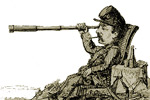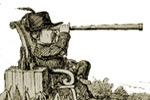

 Go Back |
 |
 Signal Service |
|
Like many, I have often wondered what Gettysburg must have looked like from the top of the Lutheran Theological Seminary. The cupola, of course, is the "gazebo" that sits atop what must be the most famous structure of the Civil War; Schmucker Hall, which is generally thought of as the main building of the Lutheran Theological Seminary. It was from this vantage point on July 1st that Brig. Gen. John Buford surveyed the choice battleground that Gettysburg offered as he awaited the approach of Maj. Gen. Henry Heth's Confederate division and its collision with his dismounted troopers on Herr's Ridge, and then McPherson's Ridge. It was from the cupola that Buford hailed the timely arrival of Maj. Gen. John Reynolds, commander of the left wing of the Army of the Potomac (A scene made all the more famous by its appearance in Michael Shaara's KILLER ANGELS, and then in the movie GETTYSBURG).
Buford's chief signal officer, Lieutenant Aaron Jerome, witnessed the general's famous exchange and many other events of the battle's first day. His poignant 1865 letter to another soldier who gained fame at Gettysburg, Winfield Scott Hancock, describes some of what he saw that day:
As it is known, the stiff resistance offered by Buford's cavalrymen wouldn't last. The Federals were swept off McPherson's Ridge and pushed back towards Seminary Ridge. There, the Union troops would regroup for another stand, and the ridge's
namesake would find itself in the middle of a hot fight between Colonel Chapman Biddle and Colonel Abner Perrin's South Carolinians.
Schmucker Hall, which was functioning as the seminary's main administration and dormitory building in 1863, had been quickly converted into a field hospital once the shooting started on July 1st. During the battle and after, notable Confederates such as Maj. Gen. Isaac Trimble, Brig. Gen. James Kemper and major Henry K. Douglas, would be treated there. Lieutenant Colonel George McFarland of the 151st Pennsylvania was shot through both legs just outside of the building on that July 1st day, and would be treated there until September 16, 1863, the longest stay of any patient who was treated in the building. The 142nd Pennsylvania's wounded colonel, Robert P. Cummins, wasn't so lucky. He died within hours in a first floor room. Schmucker Hall itself took several shots, including artillery fire that tore away a portion of its northeast corner. Unfortunately, not many eyewitness accounts, beyond that of Jerome's remain. The Federal stand on Seminary Ridge was ultimately broken, and by late afternoon of July 1st, through the end of the battle, Schucker Hall was in Southern hands. It would be highly unlikely that the Confederates didn't take advantage of what was the best vantage point anywhere in the area, but for various reasons accounts of this either have been lost or were never written down in the first place. There were rumors that Robert E. Lee made his way up to the cupola at some point during the three day battle (as depicted in the above painting), but solid evidence of that is still lacking. Because Schmucker Hall continued to be used as a hospital, it is possible soldiers were reluctant to make any mention in official reports of using the cupola for observation, as this would have been a breach of military protocol. One can only wonder about the incredible scene of martial beauty, followed by several minutes of absolute hell on earth, that Pickett's Charge would have been from that signal/observation vantage point. Also see: The Signal Corps At Gettysburg ~ A Communicator's Guide
[Compiled Excerpts from "Civil War Times, October 2006", by Chris W. Lewis, "The Signal Corps in the War of the Rebellion", by J. Willard Brown, and "A Manual of Signals", by A.J. Myer. for The Signal Corps Association Research Division SCARD, by Mark C. Hageman] |